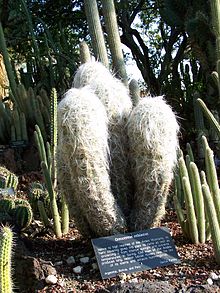Oreocereus celsianus
This article includes a list of general references, but it remains largely unverified because it lacks sufficient corresponding inline citations. (November 2012) |
| Oreocereus celsianus | |
|---|---|

| |
| Scientific classification | |
| Kingdom: | Plantae |
| Clade: | Tracheophytes |
| Clade: | Angiosperms |
| Clade: | Eudicots |
| Order: | Caryophyllales |
| Family: | Cactaceae |
| Subfamily: | Cactoideae |
| Genus: | Oreocereus |
| Species: | O. celsianus
|
| Binomial name | |
| Oreocereus celsianus | |
| Synonyms[1] | |
| |
Oreocereus celsianus, or the "old man of the mountain" is a member of the family Cactaceae native to the high lands of the Andes in South America, and is named for its fluffy white hair, which may protect it from intense sunlight and extreme temperatures.
Distribution[]
Oreocereus celsianus occurs naturally at high altitudes across Argentina, Bolivia and Peru.
Description[]
Growing to around 3 metres (10 ft) tall, O. celsianus is covered in a downy white hair, with greatest density at the tips of stems receding to near-bare at the base. The ribbed body has many long, brown spines and blooms in spring with long, tubular red flowers.
Ecology[]
Pollinated by hummingbirds in spring.
Cultivation[]
Thrives at 10–12 °C (50–54 °F), with a of down to −12 °C (10 °F) and requiring protection from hot sunlight. Prefers full sun and light watering. Propagates from seed.

References[]
- Trichocereeae
- Flora of South America
- Plants described in 1850